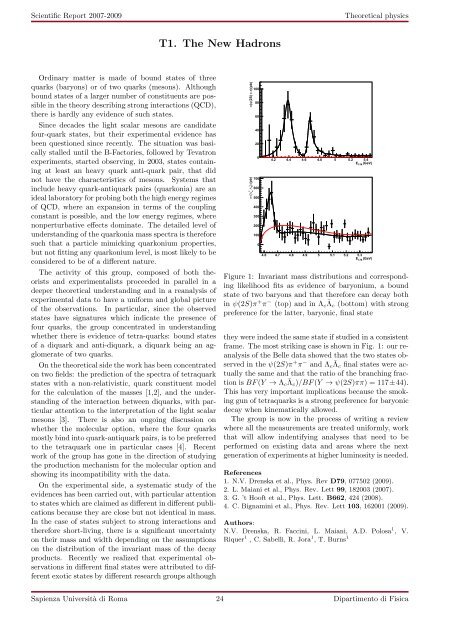download report - Sapienza
download report - Sapienza
download report - Sapienza
You also want an ePaper? Increase the reach of your titles
YUMPU automatically turns print PDFs into web optimized ePapers that Google loves.
+<br />
c<br />
Scientific Report 2007-2009<br />
Theoretical physics<br />
T1. The New Hadrons<br />
Ordinary matter is made of bound states of three<br />
quarks (baryons) or of two quarks (mesons). Although<br />
bound states of a larger number of constituents are possible<br />
in the theory describing strong interactions (QCD),<br />
there is hardly any evidence of such states.<br />
Since decades the light scalar mesons are candidate<br />
four-quark states, but their experimental evidence has<br />
been questioned since recently. The situation was basically<br />
stalled until the B-Factories, followed by Tevatron<br />
experiments, started observing, in 2003, states containing<br />
at least an heavy quark anti-quark pair, that did<br />
not have the characteristics of mesons. Systems that<br />
include heavy quark-antiquark pairs (quarkonia) are an<br />
ideal laboratory for probing both the high energy regimes<br />
of QCD, where an expansion in terms of the coupling<br />
constant is possible, and the low energy regimes, where<br />
nonperturbative effects dominate. The detailed level of<br />
understanding of the quarkonia mass spectra is therefore<br />
such that a particle mimicking quarkonium properties,<br />
but not fitting any quarkonium level, is most likely to be<br />
considered to be of a different nature.<br />
The activity of this group, composed of both theorists<br />
and experimentalists proceeded in parallel in a<br />
deeper theoretical understanding and in a reanalysis of<br />
experimental data to have a uniform and global picture<br />
of the observations. In particular, since the observed<br />
states have signatures which indicate the presence of<br />
four quarks, the group concentrated in understanding<br />
whether there is evidence of tetra-quarks: bound states<br />
of a diquark and anti-diquark, a diquark being an agglomerate<br />
of two quarks.<br />
On the theoretical side the work has been concentrated<br />
on two fields: the prediction of the spectra of tetraquark<br />
states with a non-relativistic, quark constituent model<br />
for the calculation of the masses [1,2], and the understanding<br />
of the interaction between diquarks, with particular<br />
attention to the interpretation of the light scalar<br />
mesons [3]. There is also an ongoing discussion on<br />
whether the molecular option, where the four quarks<br />
mostly bind into quark-antiquark pairs, is to be preferred<br />
to the tetraquark one in particular cases [4]. Recent<br />
work of the group has gone in the direction of studying<br />
the production mechanism for the molecular option and<br />
showing its incompatibility with the data.<br />
On the experimental side, a systematic study of the<br />
evidences has been carried out, with particular attention<br />
to states which are claimed as different in different publications<br />
because they are close but not identical in mass.<br />
In the case of states subject to strong interactions and<br />
therefore short-living, there is a significant uncertainty<br />
on their mass and width depending on the assumptions<br />
on the distribution of the invariant mass of the decay<br />
products. Recently we realized that experimental observations<br />
in different final states were attributed to different<br />
exotic states by different research groups although<br />
σ(ψ(2S) π π)(pb)<br />
-<br />
c) (pb)<br />
Λ<br />
σ (Λ<br />
100<br />
80<br />
60<br />
40<br />
20<br />
0<br />
700<br />
600<br />
500<br />
400<br />
300<br />
200<br />
100<br />
0<br />
4.2 4.4 4.6 4.8 5 5.2 5.4<br />
E C.M. (GeV)<br />
4.6 4.7 4.8 4.9 5 5.1 5.2 5.3<br />
E C.M. (GeV)<br />
Figure 1: Invariant mass distributions and corresponding<br />
likelihood fits as evidence of baryonium, a bound<br />
state of two baryons and that therefore can decay both<br />
in ψ(2S)π + π − (top) and in Λ c ¯Λc (bottom) with strong<br />
preference for the latter, baryonic, final state<br />
they were indeed the same state if studied in a consistent<br />
frame. The most striking case is shown in Fig. 1: our reanalysis<br />
of the Belle data showed that the two states observed<br />
in the ψ(2S)π + π − and Λ c ¯Λc final states were actually<br />
the same and that the ratio of the branching fraction<br />
is BF (Y → Λ c ¯Λc )/BF (Y → ψ(2S)ππ) = 117±44).<br />
This has very important implications because the smoking<br />
gun of tetraquarks is a strong preference for baryonic<br />
decay when kinematically allowed.<br />
The group is now in the process of writing a review<br />
where all the measurements are treated uniformly, work<br />
that will allow indentifying analyses that need to be<br />
performed on existing data and areas where the next<br />
generation of experiments at higher luminosity is needed.<br />
References<br />
1. N.V. Drenska et al., Phys. Rev D79, 077502 (2009).<br />
2. L. Maiani et al., Phys. Rev. Lett 99, 182003 (2007).<br />
3. G. ’t Hooft et al., Phys. Lett. B662, 424 (2008).<br />
4. C. Bignamini et al., Phys. Rev. Lett 103, 162001 (2009).<br />
Authors:<br />
N.V. Drenska, R. Faccini, L. Maiani, A.D. Polosa 1 , V.<br />
Riquer 1 , C. Sabelli, R. Jora 1 , T. Burns 1<br />
<strong>Sapienza</strong> Università di Roma 24 Dipartimento di Fisica

















